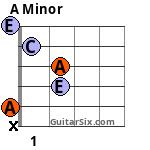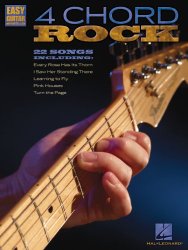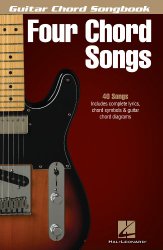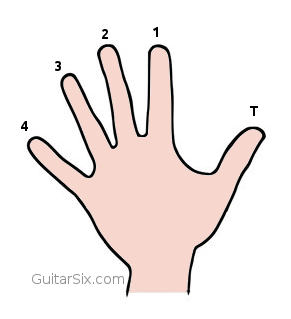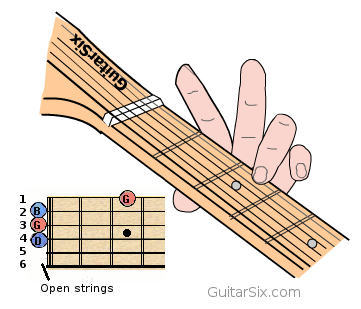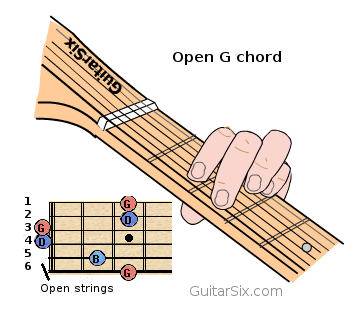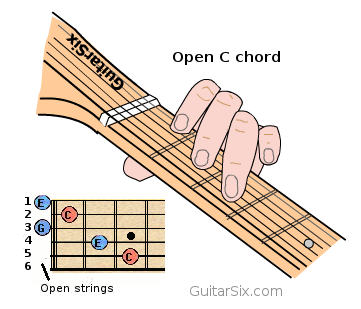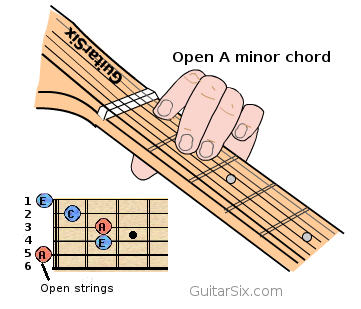Chords Guitar - Google Blog Search |
| All <b>Guitar Chords</b> In Open Position - GuitarSix.com Posted: 31 Jul 2015 12:00 AM PDT Have you ever wanted to know all the guitar chords you could possibly play in the open position? Well now you can! I made this handy reference you can download and use to learn all guitar chords in the first few frets of the guitar. What are Open chords?Open chords, also known as cowboy chords or campfire chords, are chords that use at least one open string and are played in the first few frets of the guitar. HUGE FREE list of 1200+ open chords!There happens to be approximately 1200 open chords as far as I can tell. The list is so big that I had to put them in a free PDF download. You can find the PDF here or click the PDF download link below. (Right click then save as)  What's in the PDF?Below is a small sampling of the chords you can find in the PDF. * Note: In the PDF, don't get confused when you see a note like CX where a D should be. CX means C## (double sharp). CX is the same as D. This happens in A# chords.
Want more guitar chords?I put together another PDF with over 10,000 guitar chords HERE: http://guitarsix.com/guitar/lessons/guitar-chords/142/. Also, Be sure to subscribe below if you want to be notified when I release more chord books. If you found this helpful, please help others by sharing... |
| Easy Jazz <b>Chords</b> for <b>Guitar</b> | MATT WARNOCK <b>GUITAR</b> Posted: 10 Oct 2015 01:53 AM PDT  Easy Jazz Chords for Guitar  When learning to comp Jazz guitar chords, you'll often find that Jazz shapes can be difficult to grab for the beginner Jazz guitarist. While there are a number of shapes that'll take time to master, you'll be happy to find out that there are also many easy Jazz chords for guitar that you can learn. By working on smaller, easier to play guitar chords, you'll be able to confidently outline chord progressions without having to grow an extra finger to reach big chords in the process. This'll give you the foundation you need to outline changes, and then move on to more advanced Jazz chords from there in your studies. In this lesson, you'll learn what Jazz chords are, why these shapes are considered easier to play than others, and practice playing easy Jazz chords over Jazz chord progressions and standards.
Easy Jazz Chords Contents
What Are Jazz Guitar ChordsBefore you get started learning how to play these easy Jazz chords, let's take a look at exactly what makes a guitar chord sound Jazzy. Now, there really is no such thing as a "Jazz guitar chord." This is because there are only guitar chords, some or all of which are used in many other musical genres besides Jazz. But, though many genres use similar chords to Jazz, there is a guideline you can use to help define the chords that Jazz guitarists like to use in their playing.
So, when learning how to play Jazz guitar, working on 7th chords is the best place to begin, as it'll set you up to learn extended chords as you progress in your studies. To help you hear and see the difference between a triad, the three-note chords popular in Rock and other genres, and 7th chords, here's a C and Cmaj7 chord side by side. Play them back-to-back to hear how they sound similar, but the Cmaj7 has a bit more "color" as compared to the C triad. Click to hear easy jazz chords 1 As you progress throughout this lesson, you'll be focusing on building your 7th chord vocabulary. You'll learn three-note root based and rootless 7th chords, as well as two-note shapes that you can use to play your favorite Jazz chord progressions on guitar. From there, once the material in this lesson is comfortable, you'll have built a strong foundation that you can use to move on to 9th, 11th, and 13th chords in the practice room. So, now that you know Jazz chords are shapes that extend beyond the triad, you can learn why the shapes in this lesson are considered easy Jazz chords. Why Are These Guitar Chords Considered EasyWhen you think of the term Jazz guitar chord, you probably don't associate those shapes with the word "easy." But, while there are many Jazz guitar chords that are difficult to play for beginner Jazzers, there are also shapes that can be easy to get under your fingers. These two and three-note shapes will not only introduce you to the world of Jazz chords on guitar, but they'll become a go-to resource in your comping, chord soloing, and chord melody phrases for years to come. To begin, let's take a look at some typical Cmaj7 shapes on the guitar, ones that would be difficult for many beginner Jazz guitarists to play. Click to hear easy jazz chords 2 As you can see and feel, some of these shapes have barres and stretches that can be tricky to get under your fingers. While this may deter many players from continuing their Jazz guitar studies, there are other, easier shapes that you can bring to the fretboard in studies. In the next example, you'll see a typical Jazz guitar chord, followed by three easy Jazz chords in the same position. As you'll see, the 2nd, 3rd, and 4th chords in the sequence are much easier to play. Give them a try and see what you think. Click to hear easy jazz chords 3 If you've played through the examples, you might have figured out that the first shape is still being played in the other three; you're just removing notes to make it easier to fingering on the fretboard.
Here's an example of another typical Jazz chord, one that's tricky to play, with the 5th taken out in the second example that makes it easier to finger on the guitar. Click to hear easy jazz chords 4 When taking notes out of more complex shapes, you'll create three common chord shapes on the fretboard.
These three shapes will be the basis for your studies in this lesson. Now, while these chords are easy to play, some only require one finger and many don't have barres or just two-string barres in their construction, there are some roadblocks that you will encounter with these chords. The first will arise when you reach the 3rds and 7ths below. Though these chords are the easiest to play in the lesson, they don't have a root note. Because of this, you'll have to learn how to play these chords on the correct fret without the aid of a root note to guide you. To help you get over this roadblock, there are tips and exercises presented below. But, if you get stuck with those shapes in your studies, learn the examples as written, go slow, work the suggested exercises, and over time you'll be able to find any rootless chord quickly and easily in your playing. Now that you know why these are easy Jazz chords, and the biggest obstacle you'll face when learning these shapes, you can explore effective and efficient ways to practice these shapes on the guitar. How to Practice Easy Jazz chordsWhen learning how to play easy Jazz chords, especially for beginner Jazz guitarists, it can often seem like memorizing the shapes is enough. But, memorizing Jazz chord shapes is just the beginning. If you can play a shape from memory you've got it in your fingers, but there's a difference between reciting shapes and applying them to chord progressions in real time. To get you move beyond memorization, here are a number of exercises that you can use to make the most of your time studying easy Jazz chords in the woodshed.
As you can see, there's a lot of work in that list of exercises. Don't feel that you have to work on every exercise in that list. Instead, use the list as a reference and pick a few exercises to work on to get started. From there, you can move on to other chord shapes and sections of the lesson and try other exercises with those new chords. There'll be other, chord specific, exercises below. But, for now, you can use this list as a reference chart when working these, or any, Jazz guitar chord shapes in your practice routine. So, enough talking, time to take these shapes to the fretboard. Shell VoicingsThe first set of each Jazz chords that you'll learn on guitar, are shell voicings. Shell voicings are three-note chords that contain the root, third and seventh of the underlying chord change. There are other options and extensions that people use when comping shell voicings, but these two are the best place to start. When building shell chords on the guitar, you'll find two options for fingerings.
Though they only have three notes, shell voicings can provide you all the information you need to sound the essential notes of any chord. Here is a list of the functions of each note in any shell chord.
As you'll see below, these chords sound great, but they don't outline every chord change directly, such as m7b5 chords where you need the 5th to tell m7b5 apart from m7. You'll explore ways to outlining m7b5 chords in later examples in this lesson. To begin your studies of shell chords, it's time to take them to the fretboard. Rather than learn a number of fingerings for shell voicings over different chord qualities, you're going to take these chords directly to chord progressions in your studies. This way, you'll learn how to play shell chords on guitar, as well as be able to apply them to popular Jazz progressions at the same time. The two progressions that you'll study in this lesson are major and minor key turnarounds, beginning with the major key ii V I VI progression. The first major ii V I VI example begins with a R-7-3 Dm7 chord and then moves to the closest chord shapes from there in the progression. When doing so, you'll use the following intervals for each chord.
Go slow with these chords if they're new to you. Play each chord separately until you've got it under your fingers. Then, when your comfortable, you can bring the progression together, first on your own, then with a metronome, and finally with the example and jam tracks below. Once you can play them from memory with the jam track, begin to alter the rhythm and experiment with your picking/strumming options with each chord. This'll get the chords under your fingers, and give you practice being creative with Jazz chords in your playing at the same time. Major ii V I VI Backing Track 2 5 1 C Slow No Piano Click to hear easy jazz chords 5 In the second major turnaround progression, you'll begin with a R-3-7 Dm7 chord, moving on to the closest shapes for each subsequent chord from there. Once you can play these first two examples, put on the backing track and jam over those changes while moving between both positions. This'll teach you to shift between fretboard positions as you comp over common Jazz progressions, such as major turnaround chords. As well, feel free to stay in C major with these chords, as written, or you can challenge yourself further by moving these chords to other keys on the neck in your practice routine. Major ii V I VI Backing Track 2 5 1 C Slow No Piano Click to hear easy jazz chords 6 In the next set of examples, you'll learn how to play shell chords over a minor turnaround progression, iim7b5-V7alt-Im6-bIIImaj7. When doing so, you'll outline the following intervals for each chord.
Notice that there's a Cm6 chord in this progression, a common sub for m7 chords when playing in minor keys, especially over Im7 chords. You'll also notice is that the Dm7 and G7 chords have the same notes as the Dm7b5 and G7alt chords. This is because there is no 5th in a shell voicing, and Dm7 and Dm7b5 share the same 3rd and 7th. As well, G7 and G7alt share the same 3rd and 7th and so are the same shape on the fretboard when using shell voicings over these changes. Minor ii V I bIII Backing Track 2 5 1 Cm Slow No Piano Click to hear easy jazz chords 7 The final shell voicing example starts with a R-3-7 Dm7b5 chord and moves on to the closest shapes for each new chord change from there. When you have these shapes under your fingers, put on the backing track below and move between both minor turnaround chord groups in your playing. That'll get the chords under your fingers, as well as give you practice moving around the fretboard in your comping at the same time. Minor ii V IbIII Backing Track 2 5 1 Cm Slow No Piano Click to hear easy jazz chords 8 3rd and 7th ChordsThe second group of easy Jazz chords are some of the easiest to play shapes you'll ever encounter, 3rds and 7ths. Now, while 3rds and 7ths are easy to paly, often using one or at most two fingers, they do offer a particular challenge to beginning Jazz guitar players, there's no root note. Because there's no root note, you'll have to learn how to visualize the root note while note playing it in order to ensure you're fingering the correct 3rds and 7ths. This'll take a bit of time to master. But, in the meantime you can learn how to play these shapes and apply them to common progressions as you build your ability to play rootless chords in real time over Jazz standards. When playing 3rds and 7ths, you've got two inversions to choose from. From there, you can apply those two inversions to various string sets on the guitar. To make things easy in the beginning, focus on the 4th and 3rd strings when playing these two-note chords on the guitar. From there, once you're comfortable, you can move them to the 5th and 4th strings as you expand upon these ideas on the fretboard. One thing you may be asking yourself at this point is:
Well, as you learned with shell voicings, the 3rd tells you if a chord is major or minor, and the 7th tells you if the chord is maj7, 7, m7, mMaj7 etc. If you have a bass player, they'll be covering the root note for you, which frees you up to only play the 3rd and 7th on the guitar. Then, if you don't have a bass player, you might be surprised at how well the 3rd and 7th defines the chord progression on their own. When working through the chords below, play them without the backing track and see if you can still hear the chord progression moving by. Most people can still hear the changes, even without the root note. This is why 3rds and 7ths are so powerful, and are essential Jazz chords for any guitarist to have under their fingers. The first major turnaround example starts with a 7-3 chord over Dm7 and then moves to the closest chord shape from that starting point. When doing so, you'll use the following intervals for each chord.
One thing to notice with 3rds and 7ths, is that you'll barely move your hand as you outline the changes. This is an added bonus, you're able to outline the chords and use minimal movement on the fretboard at the same time. Major ii V I VI Backing Track 2 5 1 C Slow No Piano Click to hear easy jazz chords 9 The second example starts with the 3rd and 7th for Dm7 and move to the closest shapes from that starting point. If you are having trouble finding the root notes on the guitar close to these two-note shapes, you can do a few exercises to help you always know where the root note is.
These three exercises can be applied to any 3rd and 7th shape, and are a great way to work on you root visualization in the woodshed. Major ii V I VI Backing Track 2 5 1 C Slow No Piano Click to hear easy jazz chords 10 Moving on to minor key turnaround, here's an example that starts with a Dm7b5 3rd and 7th and moves to closest chord shapes from there. As you saw in the previous section, the lack of a 5th over Dm7b5 and the altered notes over G7alt prevents those chords from totally sounding on the guitar. But, the strength of the 3rd and 7th is enough to carry the progression, with or without a bass player. When playing minor key 3rds and 7ths, you'll use the following intervals for each chord.
You'll notice that there's a Cm6 chord in the progression, and therefore the b7 you'd expect over that chord is replaced with a 6th interval. This is common in Jazz, especially with Im7 chords, and so it's worth exploring and applying to your practice routine. Minor ii V I bIII Backing Track 2 5 1 Cm Slow No Piano Click to hear easy jazz chords 11 The final 3rd and 7th example begins with the Dm7b5 3rd and 7th intervals, then moves to the closest subsequent chords from that starting point. Once you have these shapes under your fingers, put on the backing track and mix together both positions as you work on shifting in your comping. This is tougher with 3rds and 7ths, as there are no root notes, which are usually the first note you visualize when shifting chords around the fretboard. Go slow when working on shifting rootless chords, visualize the root notes, and build up the tempo in this exercise from there. Minor ii V I bIII Backing Track 2 5 1 Cm Slow No Piano Click to hear easy jazz chords 12 357 Triads – Rootless ChordsThe last group of easy Jazz chords that you'll learn are three-note rootless shapes containing the 3-5-7 of each chord. These shapes build on the 3rds and 7ths you learned in the previous section, you're now bringing in the 5th for some added color to those two-note chords. When doing so, you'll produce the following interval groups for each chord.
As well, when using 357 chords, these shapes form triads on the guitar. This can make it easy to learn if you already know how to play triads on guitar. If not, triads are easy to finger on the fretboard, and won't take long to get under your fingers if they're new at this stage in your playing. After learning any of these examples, practice moving between 37 and 357 chords to begin hearing and seeing how they're similar, yet unique, on the fretboard. Lastly, there are many different string sets to explore with 357 chords. To keep things focused, you'll learn 357 chords on the 432 string set in this lesson. These strings are perfect for 357 chords, as they sound the chord, stay out of the way of the bass player, and don't interfere with the soloist at the same time. Once you've worked out this string set, you can expand to other strings as you take these shapes further in your studies. The first example starts with a 357 Dm7 chord and moves to the closest next shape from that starting point. When doing so, you'll use the following triads for each chord.
Knowing which triads are being used for each 7th chord will allow you to apply 357 chords to other musical situations, as each triad is always associated with the same 7th chord in any key or tune. For example, any m7 chord can be played with a major triad from the 3rd of that chord, such as F over Dm7 or C over Am7. Now, having said that, in the first example you'll see the b13 being used over A7, which isn't part of a triad. Since you'll often see the VI chord in Jazz written as a VI7b9 or VI7b13, I've included that alteration for you to explore on the guitar in the first example. The second example features the C#dim triad over A7 to use as a comparison. Major ii V I VI Backing Track 2 5 1 C Slow No Piano Click to hear easy jazz chords 13 Moving on, you'll now play the Dm7 with the intervals 573, moving to the closest chord from that starting point. Practice moving between these first two chord positions before moving on to the next example, as you have three positions of 357 chords to learn on the guitar. Major ii V I VI Backing Track 2 5 1 C Slow No Piano Click to hear easy jazz chords 14 In order to cover the entire neck with 357 chords, you'll need to learn three different positions. This example begins with the 735 Dm7 chord and moves through the changes from that starting point. After learning this example, begin jamming over the backing track and jump between the three positions for major turnaround 357 chords you've learned in this section of the lesson. Major ii V I VI Backing Track 2 5 1 C Slow No Piano Click to hear easy jazz chords 15 Moving on, you'll now play 357 rootless chords over a minor turnaround progression. When doing so, you won't be using triads for every chord, as G7alt and Cm6 don't produce triads with these chord shapes. Here are the intervals used over each chord.
As you can see, some chords produce triads while others don't. You'll also notice that you're now outlining the b5 in each m7b5 chord, as well as the #5, an altered note, in the G7alt chord. This'll help you get a bit of color over those chords, and help differentiate them from their major key counterparts. Minor ii V I bIII Backing Track 2 5 1 Cm Slow No Piano Click to hear easy jazz chords 16 In the next progression you'll play the 573 Dm7b5 shape and move on to the closest next chord from there. Once you can play these first two positions, practice moving between them as you take them to the backing track below. Minor ii V I bIII Backing Track 2 5 1 Cm Slow No Piano Click to hear easy jazz chords 17 The final example uses the 735 Dm7b5 chord and moves to the next closest chord shapes from that starting point. After getting these chords down, put on the backing track and move between all three minor turnaround examples as you begin to work on shifting in your guitar practicing. Minor ii V I bIII Backing Track 2 5 1 Cm Slow No Piano Click to hear easy jazz chords 18 Major Jazz Blues StudiesNow that you've learned how to play easy Jazz chords, and apply them to major and minor progressions, you're ready to take them to larger forms. In this section, you'll learn three major Jazz Blues studies that are built using the easy Jazz chords from the previous sections of the lesson. Each study mixes both positions of chords you studied earlier, so you'll have a shift or two to navigate in each example. As well, the studies are written with a static rhythm to make it easier to get these shapes under your fingers in the beginning. From there, once any study is memorized, take them to the jam track and practice altering the rhythms as you take each study further in the practice room. Lastly, make sure to memorize the shapes as you go, and memorize the root-note positions for the rootless shapes. By doing so, you'll not only learn these chord studies, you'll build your ability to apply these easy Jazz chords to other musical situations. Major Jazz Blues Shell ChordsThe first chord study uses shell chords to outline a Jazz Blues chord progression in G. The chords are written with a steady half-note rhythm that you can use as a starting point in your studies. Once you've got this rhythm under your fingers, and the chords memorized, comp them over the backing track, altering the rhythm as you go. As you can see, the chords are a mixture of the two positions learned earlier. This means that you'll have to move around the fretboard a bit more than you have so far in the lesson. If this poses a technical problem, go slow, and isolate those shifts in your practice routine. When they're comfortable, speed them up and bring them back into the phrase and study as a whole. This will allow you to both play the study with confidence, and increase your ability to navigate shifts on the fretboard at the same time. G Blues Backing Track Blues G Slow No Piano Click to hear easy jazz chords 19 Major Jazz Blues 3rds and 7thsIn the next Jazz Blues chord study, you'll use 3rds and 7ths to outline each chord in a G Blues progression. This study uses a steady quarter-note rhythm, which again you can use to get you going with this study before moving on to other rhythms from there. As well, once you get this example under your fingers, and memorized, you can begin to mix the shell voicings and 3rds and 7ths in your comping practice. In the woodshed it's beneficial to isolate chord types such as these two shapes. But, in the real world you'll move between shapes at will and as the musical situation dictates. So, feel free to push your practicing in that direction if it feels OK and comfortable to do so. G Blues Backing Track Blues G Slow No Piano Click to hear easy jazz chords 20 Major Jazz Blues 357 ChordsIn the final major Blues chord study, you'll use the rootless three-note shapes that you learned previously to outline the chord progression. If you're having trouble finding the root notes of these shapes in your playing, feel free to slow way down and practice playing the root note of each chord followed by the shape. This'll help you learn the chords, relate those shapes to the root notes, and be able to apply them to other musical situations in your playing from there. After you can identify the closest root note for each shape, speed the study back up and work on playing it over the audio example and jam track below. From there, you can begin to alter the rhythms as you expand upon this chord study in your woodshedding. G Blues Backing Track Blues G Slow No Piano Click to hear easy jazz chords 21 Minor Jazz Blues StudiesTo finish your study of easy Jazz chords, you'll now apply the shapes from this lesson to another popular Jazz chord progression, the minor Jazz Blues. When jamming with other musicians, minor Jazz Blues tunes are called almost as often as their major Blues cousins. Because of their popularity, knowing how to comp over this 12-bar form with confidence will help prepare you for your next Jazz jam situation. Besides, it's also just a lot of fun to jam over these chords on guitar. As always, take your time with these studies, work them with a metronome, and memorize them as you go. Once you can play them from memory with the audio track, put on the backing track and begin to comp over those changes with the chords in the studies. If you feel ready, you can begin to change the rhythms at this point to take each chord study further in the woodshed. Minor Jazz Blues Shell ChordsThe first minor Blues study featuring easy Jazz chords uses three-note shell voicings to comp over each chord change. As you saw with the major Blues examples, this study mixes both positions of chords that you learned earlier in the lesson. Because of this, there are a few shifts that you'll have to navigate when learning this chord study. As well, the chords are written with a steady half-note rhythm to get your started. Once you've got the chords down, jam with them over the backing track and begin to add your own rhythms as you take these shapes further in your Jazz guitar practice routine. C Minor Blues Backing Track Blues Cm Slow No Piano Click to hear easy jazz chords 22 Minor Jazz Blues 3rds and 7thsMoving on, the second minor Jazz Blues chord study is built with two-note chords, the 3rds and 7ths you learned earlier. These easy Jazz chords may only have two notes, but as you learned in previous exercises, they can be tough to nail because of their lack of a root note. Because of this, visualizing the root note for any of these two-note chords will be helpful as you learn to play each shape on the guitar. Feel free to play the root note then the 3rds and 7ths at first to build that relationship on the fretboard. Or, you can play the root note, followed by the two-note chords, which will also help you use the root note as a reference when first working this chord study. If you find that you can visualize the root notes easily, or have no problems finding the 3rd and 7th of any chord without having to use the root as a reference, then simply move on to learning the study on the guitar. This easy Jazz chords study uses a steady quarter-note rhythm, which you an use as a jumping off point in your practice routine. Once you can play this rhythm, feel free to experiment with your own rhythmic variations as you jam this study over the minor Blues backing track below. C Minor Blues Backing Track Blues Cm Slow No Piano Click to hear easy jazz chords 23 Minor Jazz Blues 357 ChordsThe final minor Blues study built with easy Jazz guitar chord, features the rootless three-note shapes you learned earlier in the lesson. Again, you might need to use the root note as a reference to help find these shapes on the guitar when taking them to other situations. Or, you may find that you're able to grab them without any issue right away. To test your chord-finding skills, play the shapes in the study below and say each chord name out loud, or to yourself if you prefer. Then, after you've memorized the first four bars, do that from memory. Play the chords, say the names, but don't look at the sheet music. When you can do that comfortably, move on to the next four bars and repeat the exercise. This is another way to build your confidence and ability with rootless Jazz chords on the guitar. And again, use the static rhythm as a starting point, then move on to using your own rhythms from there as you jam these shapes over the backing track below. Lastly, you'll notice the last Cm7 chord, in bar 11 of the progression, uses the note B, the 7 of Cm7. This is a third variation that you can use when comping minor chords in Jazz. Alongside the m7 and m6 chords, this mMaj7 chord gives you another color to play with in your comping and chord soloing lines. C Minor Blues Backing Track Blues Cm Slow No Piano Click to hear easy jazz chords 24 |
| You are subscribed to email updates from Chords Guitar - Google Blog Search. To stop receiving these emails, you may unsubscribe now. | Email delivery powered by Google |
| Google Inc., 1600 Amphitheatre Parkway, Mountain View, CA 94043, United States | |
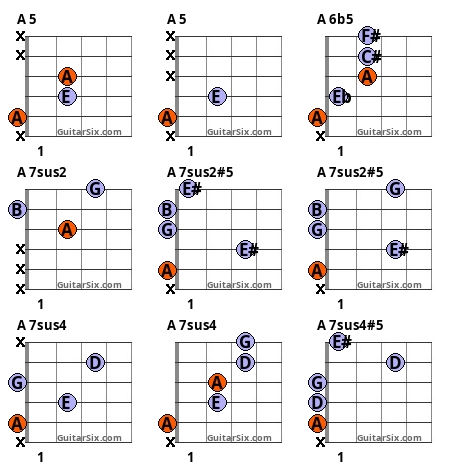

























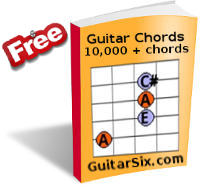
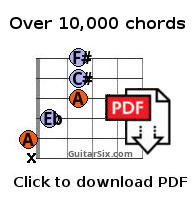

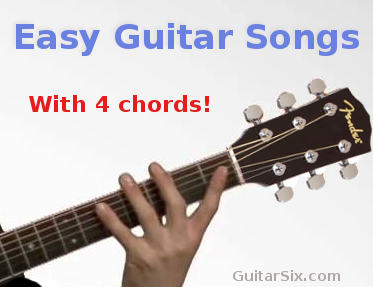
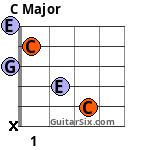 IV =
IV = 
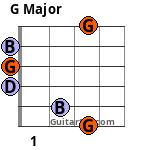 vi =
vi = 